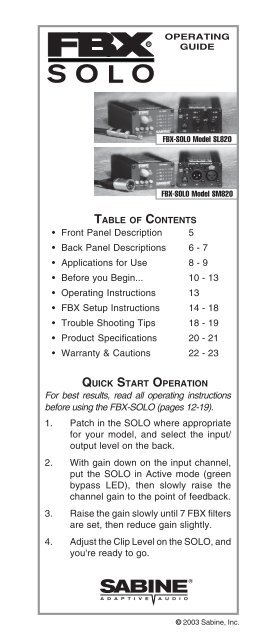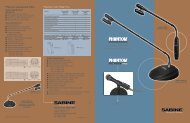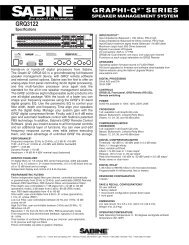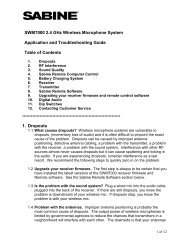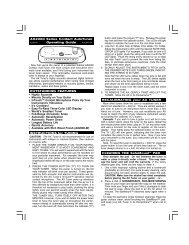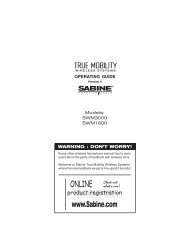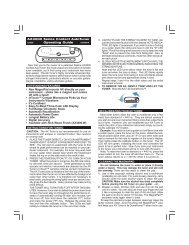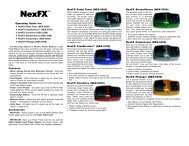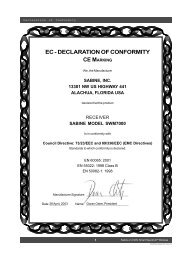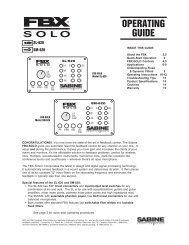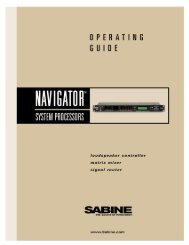FBX SOLO - Sabine, Inc.
FBX SOLO - Sabine, Inc.
FBX SOLO - Sabine, Inc.
You also want an ePaper? Increase the reach of your titles
YUMPU automatically turns print PDFs into web optimized ePapers that Google loves.
CONGRATULATIONS!You now have the state-of-the-art in feedback control.The <strong>Sabine</strong> <strong>FBX</strong>-<strong>SOLO</strong> gives you automaticreal-time feedback control for any channel of yourmix. In setup and during the performance, it givesyou more gain and increases the clarity of yourmains and monitors. It's the affordable solution tofeedback problems, perfect for wireless mics, monitors,acoustic/electric instruments, harmonica mics,multi-mic locations like conference rooms and courthouses— wherever there's an open microphone.The <strong>FBX</strong>-<strong>SOLO</strong> incorporates the latest in designand digital signal processing technology. It automaticallysenses feedback in a sound system anddetermines its pitch. It then places one of its eightconstant "Q" micro-filters on the resonating frequencyand eliminates the feedback in typically lessthan one second.Special features of the SL820 and SM820:• New ultra fast Turbo Setup Mode grabsfeedback at very low levels.• The SL820 has 1/4" in/out connectorsand input/output level switches for anycombination of ins and outs. The SL is foruse with acoustic/electric guitars and guitaramplifiers, mixer insert points, poweredmixer patch points and high impedancemics.• The SM820, with selectable phantompower, has XLR in/out connectors foruse with balanced microphones.• Both models offer standard <strong>FBX</strong> featureslike switchable filter widths and lockablefixed filters.• New improved performance - 20 bit A/Dconversion, expanded dynamic range &up to 8 <strong>FBX</strong> filters.HOW CAN THE <strong>SOLO</strong> BE USED?Assign a <strong>SOLO</strong> to any specific mixer channel. Youcan also use the SM820 to connect a phantompoweredmic to a non-phantom-powered mixer.See <strong>SOLO</strong> Applications on page 8 & 9.2
A DIRECT HIT ON FEEDBACK! The <strong>FBX</strong>-<strong>SOLO</strong>targets feedback without taking a big chunk out ofyour sound. Tests prove that a single 1/3-octave EQslider pulled down 12 dB removes almost half thepower going to the speakers over a two-octaverange. And, as the illustration above shows, youcan't place a graphic EQ filter precisely on theringing frequency. When you pull down multiplesliders in a normal setup (below), you end up withgiant holes in your sound. On the other hand, <strong>FBX</strong>constant "Q" micro-filters are 10 times narrower -you get back up to 90% of the power you lose witha graphic EQ! That means more gain before feedbackand no loss in sound quality.FREQUENCY RESPONSE TEST: Full Set-Up <strong>FBX</strong>vs. 1/3-Octave Graphic Equalizer. Test procedure: APA system was set up using a microphone, mixer, <strong>FBX</strong>,power amp and two speakers. The system's gain wasraised until the <strong>FBX</strong> removed six feedback points. Next,the <strong>FBX</strong> was replaced with a 1/3-octave graphic EQ.The EQ was adjusted while the input was raised to thesame level achieved with the <strong>FBX</strong>. The frequencyresponse curves of each device were then plotted.What this means to you: Doubling the cost of yourmicrophones, speakers and power amp probably wouldnot improve your system's frequency response as muchas replacing your EQ with an <strong>FBX</strong> for chasing feedback.4
Recommended setting of the Clip Level Adjust: theclip LED should blink intermittently. Regardless ofthe Clip Level Adjust, setting Unity on the back panelwill maintain unity gain (no net gain or loss of signallevel).When the back panel output is set to Line, the <strong>SOLO</strong>acts as a preamplifier, and the Clip Level Adjustknob becomes a gain control (see SL820 & SM820Input Low/High Switch sections below).SIGNAL LEVEL/TURBO INDICATORThe LED ladder indicates the signal strength relativeto the <strong>SOLO</strong>'s input level. Clip LED flashes independentlyto indicate when the <strong>SOLO</strong> is in Turbo Setupmode.FILTER ACTIVITYWhen one of the unit’s constant "Q" filters is activated,the corresponding LED lights. A blinking LEDindicates the filter that was most recently activated.All filter LEDs cycle to indicate Turbo Mode is aboutto disengage.FILTER WIDTH SWITCHSwitch to narrow 1/10-octave filters for music applicationsor to wider 1/5-octave filters for spoken wordapplications. The change takes effect only on powerup. Selecting a new width has no effect unless youpower down and then power up again.12 VOLT DC ADAPTORThe <strong>FBX</strong> external power supply (single unit powersupply; model # SPSPOWR) is included with theunit. Use of any other power supplies may causepermanent damage to the unit and WILL VOID THEWARRANTY.SL820 BACK PANEL ONLYINPUT LOW/HIGH SWITCHSwitch to Low for instrumentor (high impedancemicrophone) IN. Use withlow level inputs such aspiezo mic pick ups — this provides a 30 dB boost inthe <strong>FBX</strong>'s input gain structure. Switch to High forinsert or line IN: use with high level output instrumentsand signal processors.6
OUTPUT UNITY/LINE SWITCHSwitch to Unity (for level in = level out) for use withamplifiers that accept low level signals, such asguitar amps. In the Unity setting, the SL820 inputlevel equals the output level. Switch to Line (for linelevel out) if your signal needs pre-amplification. Inthe Line setting the gain is adjusted between 0 and+35 dB (High IN); +30 to +65 dB (LOW IN) via the cliplevel adjust.INPUTS & OUTPUTSThe connector labeled IN/OUT serves as both theunit's input (tip) and output (ring) when used with asingle TRS plug. When used with a Y-cord, use theIN/OUT as the input and the OUTPUT as the output(for channel insert configurations).SM820 ONLY BACK PANELOUTPUT LO/HI SWITCHIn the LO setting, theSM820 has unity gain (input= output); use LO formic level. In the HI setting,gain is adjustable between-15 dB and +20 dB usingthe clip level adjust; use HI for line level, or when youneed to preamp the signal.PHANTOM POWER ON/OFF SWITCHThe SM820 is set to "Phantom Power - OFF" at thefactory. If you wish to use phantom power, move theswitch to "ON." NOTE: The SM820 will not passphantom power from your mixer.INPUTThe input accepts balanced XLR-3 (PIN 2 high)plugs.OUTPUTUse balanced XLR-3 plugs (PIN 2 high) for balancedmixer line inputs. NOTE: the output impedance ofthe SM820 is unbalanced.7
APPLICATIONSSL820: You can use the SL820 withacoustic/electric guitars and guitaramplifiers, mixer insert points, poweredmixer patch points and highimpedance mics. Use the followingwiring diagrams as guides for setup:SL820NOTE: For Configurations 1-4, the output control on theback panel of the SL820 may actually be set to eitherUnity or Line. In the Unity setting the output level willequal the input level, and, since the input level to theSL820 in such a setup is already line level, the output willbe line level as well. When the output setting is switchedto Line, the front panel knob becomes a gain control,and it is possible to add additional gain to your signalpath, if needed. Care should be taken in this situationto avoid overdriving your mixer channel.1. Mixer Channel Insert with TRS/TRS CableNOTE: Use a TRSconnector at bothends of cable.2. Mixer Channel Insert w/ Insert "Y" CableNOTE: Use aTRS connectoronly at the mixerinsert point.3. Mixer Channel HI Impedance Mic on Line Input8
4. Instrument IN for AmpNOTE: an SL820 can be inserted at line level afterthe mixer and before the power amp on smallersystems.Note for SM820: Use the SM820with balanced microphones.SM8205. Mic Input to Mixer Line Input6. Mic Input to Mixer Mic Input9
BEFORE YOU BEGIN...The <strong>FBX</strong> automatic feedback controller improvesany sound reinforcement system. By following thesesimple instructions, you will be assured of the mostbenefit from your <strong>FBX</strong> and sound system. Theinstructions presume that you are familiar with thefundamentals of sound reinforcement. If any of theterms are not clear, or if the system does not performas expected, contact your local <strong>Sabine</strong> dealer forfurther information. Read on for a basic explanationof <strong>FBX</strong> features you should understand before usingyour <strong>FBX</strong>.POWERING UPWhen connecting thepower supply to the<strong>FBX</strong>-<strong>SOLO</strong>, angle theconnector down, thenpush the connector up into the input gently, with thelip facing up as shown. Do not force the connectorinto or out of the <strong>FBX</strong>.UNDERSTANDING FIXED & DYNAMIC FILTERSThe <strong>FBX</strong> has two types of constant “Q” filters: Fixedand Dynamic. Both filters are placed the same way:feedback is detected and the filter is placed justdeep enough to eliminate it. The difference betweenFixed and Dynamic comes after the filter is placed.Fixed filters are set automatically during the initialsetup and remain on the initially detected feedbackfrequency — they do not move. The system’s gainbefore feedback is provided by the Fixed filters; i.e.,increasing the number of Fixed filters increases thesystem’s allowable gain before feedback.The <strong>FBX</strong>’s Dynamic filters control intermittent feedbackthat occurs during the program.NOTE: Dynamic filters release only whennecessary, i.e., after all filters have set, but anew feedback frequency has been detected.These filters will not "gradually release" asthey might in other feedback controllers —leaving you unprotected and at risk of feedback.<strong>Sabine</strong>'s Dynamic filters allow for adaptive,safe, continuous feedback control duringthe performance.If Lock Fixed is not engaged, the Fixed filters willcontrol feedback during performance on their as-10
signed frequencies (configured during setup). <strong>Inc</strong>reasedactivity at one of those frequencies maycause the filter to go deeper (e.g.., deepen from -12dB to -15 dB). Activating the Lock Fix functionprevents the Fixed filters from going deeper at theirassigned frequencies.FIXED & DYNAMIC FILTER CONFIGURATIONThe filters can be reconfigured easily from thefactory default setting (six fixed and two Dynamic) toany combination of Fixed and Dynamic filters. Forexample, the following procedure will set three filtersFixed and five Dynamic:1. Place the unit in Bypass mode.2. Power down the <strong>SOLO</strong>.3. While depressing the Reset button, power upthe unit.4. Release the Reset button. The Filter IndicatorLEDs will now light in sequence.5. When the third LED is lit, press the Reset button.6. Notice that the first three LEDs flash three timesto verify that they are now the Fixed filters.Filters which do not flash are Dynamic filters.NOTE: The Fixed filters flash three times wheneverthe <strong>FBX</strong> is powered up.RESET OPTIONSThe Reset button has two functions: You can resetall the <strong>FBX</strong> filters, or just the Dynamic filters. Holdthe Reset button in and all the filter LEDs will beginflashing. To clear only the Dynamic filters, releasethe Reset button when the Dynamic filter LEDs gooff (after three flashes). To clear all the filters, do notrelease the Reset button until all the filters LEDs gooff (approximately 7 flashes). A full reset is recommendedwhenever you change speaker or microphonepositions. NOTE: Factory default is 6Fixed and 2 Dynamic filters, so if you reset Dynamicsonly those two lights will go out during reset. Andremember, whenever you perform a full reset youwill automatically be in Turbo mode.WARNING: Do not reset all filters during theprogram. This releases all the feedback you eliminatedduring setup. Use extreme caution whenresetting the Dynamic filters, because you may needthose filters at that moment during the show.11
TURBO MODE SETUPThe <strong>FBX</strong>-<strong>SOLO</strong> incorporates Turbo Mode setup,which is indicated by a flashing red Clip LED. Thislightning-quick setup feature cuts the time for <strong>FBX</strong>filter initialization to just a few seconds.NOTE: The <strong>SOLO</strong> is set in Turbo Mode at the factoryand automatically engages every time you resetfilters. The <strong>SOLO</strong> automatically returns to normalprogram mode when the first dynamic filter is set, orwhen you press the front panel Lock Fixed button. Allthe filter LEDs will cycle to indicate that Turbo Modeis about to disengage.WARNING: Turbo Mode will cause distortion inyour audio program — it is for setup only. Youmust follow the setup procedure outlined in the nextsection, and do not play program during TurboSetup Mode. Otherwise the <strong>FBX</strong>-<strong>SOLO</strong> will clip, andfilters may be set improperly. (Clip level is set to thelowest level so the feedback clips quickly; therefore,your program will also be clipped in Turbo Mode. Besure a Dynamic filter is set, and if one isn’t, press theLock Fixed button before your program begins.)You’ll know the <strong>FBX</strong>-<strong>SOLO</strong> is in Turbo Mode ifthe red Clip LED flashes and when no othersignal level LEDs are lit. You can manually overrideTurbo mode if necessary: Press Lock Fixed(the Lock Fixed light will turn on), then press it again.(Lock Fixed light will go out).MOBILE vs. STATIONARY MICROPHONESOne significant advantage offered by the <strong>Sabine</strong>family of <strong>FBX</strong> Feedback Exterminator products istheir ability to adapt to changing acoustical relationshipsinvolving sound system components and varioususer applications. One major source of potentialfeedback problems arises in situations withwireless microphones, when the user of the wirelessmic is moving around the stage/auditorium. As amicrophone moves in a sound space, with varyingdegrees of proximity to the speakers and varyingacoustic responses, feedback frequencies may shift.In such a situation, feedback-free mobility may bemore important a concern than maximum systemgain.One method of setting <strong>FBX</strong> filters with mobile microphonesis to turn a microphone on and walk aroundto the various possible microphone locations. At the12
same time, raise the system gain and set the <strong>FBX</strong>filters one at a time.In some situations, raising the number of dynamicfilters (versus fixed <strong>FBX</strong> filters) may allow a secondlayer of defense against new feedback from newlocations. However, in many mobile microphone setups, fixed <strong>FBX</strong> filters will protect against feedbackacross the range of microphone mobility.INSTRUCTIONS FOR OPERATIONSL820 SYSTEM INITIALIZING PROCEDUREChoose the input level. Switch to LO for instrumentor microphone in (use with low level inputs such aspiezo mics); this provides a 30 dB boost in the <strong>FBX</strong>’sinput gain structure. Switch to HI for insert or line in(use with high level output instruments and signalprocessors).Choose the output level. Switch to Unity when youwant level in to equal level out. In the Unity setting theSL820 has a system gain of 1 (input = output level).Switch to Line (for line level out) if your signal needspre-amplification. In the Line setting the gain is adjustedbetween 0 and +35 dB via the clip level adjust.SM820 SYSTEM INITIALIZING PROCEDURESelect Phantom Power ON/OFF. Your SM820 isdelivered from the factory with the phantom powerfunction disabled. If you wish to use phantom power,you may enable the function by switching to “PhantomPower - ON” on the back panel. The majority oflow impedance balanced non-phantom-poweredmics are wired to ignore phantom power. Check yourmicrophone owner’s manual for verification to avoiddamage. The SM820 will not pass phantom powerfrom the mixer to your mic channel and is for prefaderchannel input only.SL820 & SM820 SETUP INSTRUCTIONSFollow these steps to obtain the maximum gainbefore feedback without changing the tonal qualityof your program. Set up only one <strong>SOLO</strong> at a time.The following instructions are for using the <strong>SOLO</strong> ona channel insert. For use with monitors, substitutemonitor send and master monitor control for inputchannel level fader and mixer master output. Besure to turn off the mains when initializing the <strong>SOLO</strong>in your monitor system.13
<strong>FBX</strong> SETUP INSTRUCTIONS1Place the speakers and microphonesin the positions where theywill be used during the program.Avoid placing microphones directlyin front of speakers. If youare using a graphic EQ, adjust itonly for the desired tonal qualities.DO NOT NOTCH FORFEEDBACK.2Set the mixer master output, allchannel level faders, and themonitors to minimum.OUTPUT,INPUT &MONITORLEVELS3Turn on the <strong>SOLO</strong>. Turn on themixer, any signal processingequipment, and finally the poweramp. NOTE: compressors in the<strong>SOLO</strong> signal path should be offduring this procedure.4Press and hold the <strong>SOLO</strong>’s Resetbutton (see page 8 for more detailson the reset function) untilthe LEDs stop flashing to clearout all filters set previously.NOTE: You are now in TurboMode (see page 9 for details). Besure the “BY” LED is green toindicate the <strong>SOLO</strong> is not in bypassmode (red).5Turn the <strong>SOLO</strong>’s clip level adjustto the two o’clock position.6Set the mixer master output to anominal level.MIXER MASTER14
7Slowly raise the inputchannel levelfader for the channelbeing set until feedbackoccurs. The<strong>SOLO</strong> should quicklyremove the feedback.CHANNELINPUTLEVELFIRSTFEEDBACKTONEThe first Filter LED will thenblink to indicate a filter hasbeen set.8Keep raising the level slowlyuntil all Fixed Filters and onedynamic filter is set. Turbo SetupMode goes OFF automaticallywhen the first Dynamic filter isinitialized. Any un-initialized dynamicfilters will be set later iffeedback occurs during the program.Now lower the channel levelfader slightly so that the systemis not on the verge of anotherfeedback point. This is the maximumvolume level that the <strong>FBX</strong>-<strong>SOLO</strong> will be able to provide.Higher levels will cause uncontrollablefeedback.CHANNELINPUTLEVELCHANNELINPUTLEVEL9Finally, during sound check, adjustthe Clip Level Adjust so thatthe red Clip LED blinks intermittently,as you would adjust therecording level of a tape recorder.The unit will clip anddistort the program if the ClipLevel Adjust is set too high. If itis set too low, the signal-to-noiseratio will degrade and the systemmay hiss.IMPORTANT: Make sure Turbo modeis OFF — Clip LED NOT flashing!15
HOW TO USE THE "LOCK FIXED" FEATUREIn certain situations the <strong>FBX</strong> may mistake music forfeedback and drive the fixed filters deeper thannecessary, like in a church with a pipe organ orduring a performance with a great deal of intentionalsustained electric guitar feedback. You may preventthe fixed filters from deepening beyond theirinitial depth by pressing the Lock Fixed button on thefront panel AFTER setting the fixed filters as describedpreviously. The Lock Fixed LED will light toindicate that the <strong>FBX</strong> is in Lock Fixed mode. Thefixed filters will stay locked until you press the LockFixed button again. The dynamic filters are notaffected. In almost every situation, it is best tolock the fixed filters right after the initial setup.LIMITING TOTAL NUMBER OF ACTIVE FILTERSYou may choose to limit the total number of activefilters for each application by using the Lock Fixedbutton. For example, if you wish to use only threefixed and one dynamic filter, set the <strong>FBX</strong> so there areseven fixed and one dynamic filter. Then during thesetup procedure, simply press the Lock Fixed buttonafter setting the first three fixed filters. The remainingfour fixed filters will be locked in their zeroposition.SELECTING FILTER WIDTHIf the <strong>SOLO</strong> is to be used for a music application, 1/10-octave filters are most effective. However, in spokenword applications, such as lectures or teleconferencing,the wider 1/5-octave filters are recommended.Select the filter width using the switch on the <strong>SOLO</strong>back panel. The change takes effect only on powerup.Selecting a new width has no effect unless youpower down and then power up again.ENGAGING THE NOISE GATEOne outstanding feature of your <strong>FBX</strong>-<strong>SOLO</strong> is a userselectablenoise gate. It acts as an automatic switchthat opens a microphone only when someone isspeaking directly into it. A noise gate is especiallyuseful in systems that have a number of open microphones,such as courtrooms, conference rooms, orparliament buildings. Gating microphones greatlyreduces the number of possible feedback points inthe room and allows for more system gain.16
The level that turnsthe noise gate on andoff is called thethreshold. If the levelcoming into the gateis greater than thethreshold, the noisegate opens, and themic is turned on. If itis less than thethreshold, the noisegate closes, and the mic is turned off.You can adjust your <strong>SOLO</strong> to four different thresholdlevels (see diagram at left), or turn it off. To select thethreshold, power down the <strong>SOLO</strong>. Hold in the LockFixed button, and power up the <strong>SOLO</strong>. The clip levelLEDs will light in sequence. Select the thresholdlevel by pressing the Lock Fixed button again whenthe clip LED lights at the corresponding thresholdlevel. The noise gate is now enabled, indicated by aflashing level LED on power-up. Pressing the LockFixed button with no clip LEDs lighted turns offthe noise gate. If no lights flash on power-up, thenoise gate is not engaged. When the <strong>SOLO</strong>'snoise gate is enabled, it will not become engageduntil after you've set all fixed filters and one dynamicfilter (if the <strong>SOLO</strong> is configured for any).USING SABINE'S OPTIONAL <strong>SOLO</strong> ACCESSORIES1-U rack tray (model # SL6RACK): An optional 1-U rack tray holds up to six <strong>SOLO</strong>s (and/or <strong>Sabine</strong>'sSDA102 digital delays). Mount the SL820s, SM820s,or a combination of both side by side on the tray. Useonly <strong>Sabine</strong> supplied screws; use of any otherscrews may damage the <strong>SOLO</strong> and void the warranty.IMPORTANT OPERATING CONSIDERATIONSMEMORY: The <strong>FBX</strong> stores the positions and depthsof the filters in nonvolatile internal memory when theunit is turned off or during a power failure. The unitwill return all filters to their previous frequencies anddepths when it is turned back on.BYPASS MODE: Placing the <strong>FBX</strong>-<strong>SOLO</strong> in bypassmode only shuts down the <strong>FBX</strong> function; the micro-17
phone preamp still functions when the unit is inbypass mode. The <strong>SOLO</strong> will not pass signal if thepower is off in either active or bypass mode.RESETTING THE FILTERS: You must reset the<strong>FBX</strong> if the microphones or speakers are movedsignificantly.To reset ALL filters: press and hold the resetbutton until the filter LEDs flash about 7 times, oruntil all filter LEDs turn off.To reset only the dynamic filters: press and holdthe reset button for 3 flashes and let go. The LEDsthat indicate current dynamic filter placement will beoff, and the fixed filter LEDs will remain on.TROUBLESHOOTING TIPSQ. Can I patch the <strong>SOLO</strong> SL820 after the mixer andbefore the power amp?A. Yes, but only in cases where just eight feedbackfilters are needed, such as on the monitorsalone. Eight <strong>FBX</strong> filters may not always provideenough gain before feedback for your entire mix.Q. Sometimes I don't get enough gain before feedback.Why?A. Gain before feedback is determined by the numberof fixed filters you set; increasing the numberof fixed filters during setup increases the system'sgain before feedback. Fixed filters are setautomatically during the initial setup and remainon the initially detected feedback tone -- they donot move. You can reconfigure the filters fromthe factory default setting (six fixed and twodynamic) to any combination of fixed and dynamicfilters. Review the procedure on page 10,UNDERSTANDING FIXED AND DYNAMIC FIL-TERS of this operating guide.Q. The Clip Level LEDs do not light. The unit will notcatch feedback. Why?A. The unit is not in the signal path. Check theconnections.Q. Why does one of the Filter Activity LEDs blink?A. The last filter to be automatically updated blinks.During normal operation, the blinking will movefrom filter to filter as the <strong>SOLO</strong> finds new feedbackpoints. This gives the user a visual confirmationthat the unit is functioning properly.18
Q. Why does my <strong>SOLO</strong> set filters when music isplayed through it?A. Make sure the <strong>FBX</strong>’s Turbo Mode has turned offbefore you program. Check the signal levelladder. If the red Clip LED lights with no othersignal level LEDs lit, the <strong>FBX</strong>-<strong>SOLO</strong> is still inTurbo Mode. Turbo Mode turns off automaticallyafter the first dynamic filter is set, or you canturn it off manually by pressing the Lock Fixedbutton. Turbo Mode sets filters very quickly —without analyzing the signal — and may notdistinguish feedback from music or audio signal.Q. Why would the <strong>FBX</strong> cause a noticeable hum?A. It may hum if the system is improperly grounded.Check for bad grounds.Q. Why does my system sound thin and muffled?A. Place the <strong>SOLO</strong> in Bypass Mode. If the systemstill sounds thin, your problem is probably withimproper use of a graphic EQ. If the problemexists only with the <strong>SOLO</strong> in Active mode, verifythe clip level setting, reinitialize the system andlock the fixed filters.Q. With the SL820 in the insert point, I hear noaudio. Why?A. Your insert point may be wired opposite to the<strong>SOLO</strong>. Try reversing the tip and ring (in and out)of your Y-cord. If you are using a single TRScable, you will have to reconfigure one end of itto conform to your mixer insert point.Q. Will the <strong>SOLO</strong> eliminate feedback in both mainsand monitors?A. Yes, but for maximum gain you should set asmany fixed filters as possible on the system withthe most feedback problems. Choose whichsystem is more likely to have feedback, andfollow the system initializing procedure for eithermains or monitors. During program, the dynamicfilters will control feedback for both mainsand monitors if they are in use, but only on theinput channel the <strong>SOLO</strong> is patched into.Q. The channel I have the <strong>SOLO</strong> in seems noisy.What can I do?A. If the noise floor is too high, you need to readjustthe gain structure of that channel. Follow the<strong>SOLO</strong> initialization instructions in this guide.19
PRODUCT SPECIFICATIONSFILTERSEight independent digital notch filters controlledautomatically from 40 Hz to 20 KHzFilter width: 1/10 octave, typical, or 1/5-oct.selectable; constant "Q"Filter depth: DSP controlled, variable to -50 dBResolution: 1/50th octaveTime required to find and eliminate feedback:0.4 sec., typical @ 1 KHzTotal number of combined filters active: Userselectable, from 1-8Number of Dynamic vs. Fixed filters: UserselectableLast configuration stored in memoryINPUT/OUTPUT - SL820 ONLYI/O Connectors: 1/4" TRS; tip = input, ring =output, sleeve = groundInput Impedance: Unbalanced >1 meg OhmOutput Impedance: Unbalanced 10 Ohmsnominal; Maximum load 2K OhmsMaximum Input/Output Level at lowest gain:+20 dBVGain Range (with line out selected): 0 to +35 dB(high in), +30 to +65 dB (low in)Input to Output Gain @ unity setting: +/- 0.5 dBVBypass: DigitalINPUT/OUTPUT - SM820 ONLYI/O Connectors: XLR-3 PIN 2 high BalancedInput Impedance: 1K Ohm nominalOutput Impedance: Unbalanced 10 Ohmsnominal; Maximum load 2K OhmsMaximum Input/Output Level at lowest gain: -10dBV**Gain Range: -15 to +20 dB (at high output)Input to Output Gain @ unity setting: +/- 0.5 dBVBypass: DigitalEIN: -105 dBm @ 150 Ohms, 20 Hz - 20 KHz orbetterPhantom Power: 48V switch selectable20
PERFORMANCE***Frequency Response: < +0.75 dB, 20 Hz to 20KHzSignal to Noise Ratio: >94 dB typicalTotal Harmonic Distortion: 100 dBNOISE GATEAttack Time: Fixed (400 mS)Threshold: Selectable (-24 dB, -36 dB, -48 dB, -60dB)POWER SUPPLY8-20 VDC @ 400 mADIMENSIONS1-U height, 1/6-RU width; 2.78 x 1.65 x 5.5 in. (6.95x 4.13 x 13.75 cm)WEIGHT9 oz. (0.26 kg)OPTIONSSL6RACK Rack Tray (holds up to six units)*Below approximately 200 Hz the feedback filters becomeslightly wider to increase the capture speed of feedback andrumble at these low frequencies.**Note: Inputs may be balanced or unbalanced.***Tests performed using an Audio Precision System Onemodel 322 or equal.SPECIFICATIONS SUBJECT TO CHANGE WITHOUT NOTICE.21
EXPOSURE TO EXTREMELY HIGH NOISE LEVELS MAY CAUSE A PERMANENT HEARINGLOSS. INDIVIDUALS VARY CONSIDERABLY IN SUSCEPTIBILITY TO NOISE INDUCED HEAR-ING LOSS, BUT NEARLY EVERYONE WILL LOSE SOME HEARING IF EXPOSED TO SUFFI-CIENTLY INTENSE NOISE FOR A SUFFICIENT TIME. THE U.S. GOVERNMENT'S OCCUPA-TIONAL SAFETY AND HEALTH ADMINISTRATION (OSHA) HAS SPECIFIED THE FOLLOWINGPERMISSIBLE NOISE LEVEL EXPOSURES:DURATION/DAY SOUND LEVEL IN dBA, DURATION/DAY SOUND LEVEL IN dBA,IN HOURS SLOW RESPONSE IN HOURS SLOW RESPONSE8 906 924 953 972 1001-1/2 1021 1051/2 1101/4 or less 115ACCORDING TO OSHA, ANY EXPOSURE IN EXCESS OF THE ABOVE PERMISSIBLE LIMITSCOULD RESULT IN HEARING LOSS. EAR PLUGS OR PROTECTORS IN THE EAR CANALS OROVER THE EARS MUST BE WORN WHEN OPERATING THIS DEVICE IN ORDER TO PREVENTA PERMANENT HEARING LOSS. IF EXPOSURE IS IN EXCESS OF THE LIMITS AS SET FORTHABOVE, TO ENSURE AGAINST POTENTIALLY DANGEROUS EXPOSURE TO HIGH SOUNDPRESSURE LEVELS, IT IS RECOMMENDED THAT ALL PERSONS EXPOSED TO EQUIPMENTCAPABLE OF PRODUCING HIGH SOUND PRESSURE LEVELS SUCH AS THIS DEVICE BEPROTECTED BY HEARING PROTECTORS WHILE THIS UNIT IS IN OPERATION.1. Read all safety and operating instructions before using this product.2. All safety and operating instructions should be retained for future reference.3. Obey all cautions in the operating instructions and on the unit.4. All operating instructions should be followed.5. Use only shielded audio and data cables.6. This product should not be used in the presence of moisture or rain, or near any water, i.e., abathtub, sink, swimming pool, wet basement, etc.7. This product should be located so that its position does not interfere with proper ventilation. Donot use in direct sunlight. Do not place flat against a wall or in a built-in enclosure that will impedethe flow of cooling air.8. This product should not be placed near a source of heat such as a stove or radiator.9. Connect only to a power supply of the type marked on the unit adjacent to the power entry module.10. Never break off the ground pin on the power supply cord.11. Power supply cords should always be handled carefully. Never walk or place equipment on powersupply cords. Periodically check cords for cuts or signs of stress, especially at the plug and thepoint where the cord exits the unit.12. The power supply cord should be unplugged when the unit is to be unused for long periods of time.13. Care should be taken so that objects do not fall and liquids are not spilled into the unit through theventilation holes or any other openings.14. This unit should be checked by a qualified service technician if:A. The power supply cord or plug has been damaged.B. Anything has fallen or been spilled into the unit.C. The unit does not operate correctly.D. The unit has been dropped or the enclosure damaged.15. The user should not attempt to service this equipment. All service work should be done by aqualified service technician.OSHA 2201; 1995 revised.FCC STATEMENTWarning: Changes or modifications to this unit not expressly approved by the party responsible forcompliance could void the user's authority to operate the equipment.This device complies with Part 15, Class B, of the FCC Rules. Operation is subject to the followingconditions: (1) This device may not cause harmful interference; and (2) This device must accept anyinterference received, including interference that may cause undesired operation.NOTE: This equipment has been tested and found to comply with the limits for a Class B digitaldevice, pursuant to Part 15 of the FCC Rules. These limits are designed to provide reasonableprotection against harmful interference in a residential installation. This equipment generates, uses,and can radiate radio frequency energy and, if not installed and used in accordance with the instructions,may cause harmful interference to radio communications. However, there is no guaranteethat interference will not occur in a particular installation. If this equipment does cause harmfulinterference to radio or television reception, which can be determined by turning the equipment offand on, the user is encouraged to try to correct the interference by one or more of the followingmeasures:• Reorient or relocate the receiving antenna.• <strong>Inc</strong>rease the separation between the equipment and receiver.• Connect the equipment into an outlet on a circuit different from that to which the receiver isconnected.• Consult the dealer or an experienced radio TV technician for help.This digital apparatus does not exceed the Class B limits for radio noise emissions from digitalapparatus set out in the Radio Interference Regulations of the Canadian Department of Communications.Le present appareil numerique n'emet pas de bruits radioelectriques depassant les limites applicablesaux appareils numeriques de la class B prescrites dans le Reglement sur le brouillage radioelectriqueedicte par le ministere des Communications du Canada.Japanese EMI Statement:CAUTION22Only when used with the following <strong>Sabine</strong>-supplied power modules:AD 1280-100AD 1280-120AD 1280-230AD 1280-240AAD 1280-240U
ONE-YEAR LIMITED WARRANTY:THIS LIMITED WARRANTY VALID ONLY WHEN PURCHASED AND REGISTERED IN THEUNITED STATES OR CANADA. ALL EXPORTED PRODUCTS ARE SUBJECT TO WARRANTYAND SERVICES TO BE SPECIFIED AND PROVIDED BY THE AUTHORIZED DISTRIBUTOR FOREACH COUNTRY.Ces clauses de garantie ne sont vaiables qu’aux Etats-Unis et au Canada. Dans tous les autres pays,les clauses de garantie et de maintenance sont fixees par le distributeur national et assuree par luiselon la legislation en vigueur.Diese Garantie ist nur in den USA and Kanada gultig. Alle Export-Produkte sind der Garantie und demService des Importeurs des jewelligen Landes untervorfen.Esta garantia es valida solamente cuando el producto es comprado en E.U. continentales o en Canada.Todos los productos que sean comprados en el extranjero, estan sujetos a las garantias y servicio quecada distribuidor autorizado determine y otrezca en los diterentes paises.ONE-YEAR LIMITED WARRANTY/REMEDYSABINE, INC. (“SABINE”) warrants this product to be free from defects in material and workmanshipfor a period of one (1) year from date of purchase PROVlDED, however, that this limited warranty isextended only to the original retail purchaser and is subject to the conditions, exclusions and limitationshereinafter set forth:CONDITIONS, EXCLUSIONS AND LIMITATIONS OF LIMITED WARRANTIESThese limited warranties shall be void and of no effect if:a. The first purchase of the product is for the purpose of resale; orb. The original retail purchase is not made from an AUTHORIZED SABINE DEALER; orc. The product has been damaged by accident or unreasonable use, neglect, improper service ormaintenance, or other causes not arising out of defects in material or workmanship; ord. The serial number affixed to the product is altered, defaced or removed; ore. The power supply grounding pin is removed or otherwise defeated. In the event of a defect inmaterial and/or workmanship covered by this limited warranty, <strong>Sabine</strong> will repair the defect in materialor workmanship or replace the product, at <strong>Sabine</strong>’s option; and provided, however, that, in any case,all costs of shipping, if necessary, are paid by you, the purchaser.THE WARRANTY REGISTRATION CARD SHOULD BE ACCURATELY COMPLETED, MAILED TOAND RECEIVED BY SABINE WITHIN FOURTEEN (14) DAYS FROM THE DATE OF YOURPURCHASE.In order to obtain service under these warranties, you must:a. Bring the defective item to any AUTHORlZED SABlNE DEALER and present therewith the ORIGI-NAL PROOF OF PURCHASE supplied to you by the AUTHORIZED SABINE DEALER in connectionwith your purchase from him of this product. If the DEALER is unable to provide the necessarywarranty service, you will be directed to the nearest other SABINE AUTHORIZED DEALER which canprovide such service. ORb. Call <strong>Sabine</strong> for a RETURN AUTHORIZATION NUMBER and ship the defective item, prepaid, to:SABINE, INC. 13301 HIGHWAY 441ALACHUA, FL 32615-8544 USAincluding therewith a complete, detailed description of the problem, together with a legible copy of theoriginal PROOF OF PURCHASE and a complete return address. Upon <strong>Sabine</strong>’s receipt of theseitems:If the defect is remedial under the limited warranties and the other terms and conditions expressedhave been complied with, <strong>Sabine</strong> will provide the necessary warranty service to repair or replace theproduct and will return it, FREIGHT COLLECT, to you, the purchaser.<strong>Sabine</strong>’s liability to the purchaser for damages from any cause whatsoever and regardless of the formof action, including negligence, is limited to the actual damages up to the greater of $500.00 or anamount equal to the purchase price of the product that caused the damage or that is the subject of oris directly related to the cause of action. Such purchase price will be that in effect for the specificproduct when the cause of action arose. This limitation of liability will not apply to claims for personalinjury or damage to real property or tangible personal property allegedly caused by <strong>Sabine</strong>’s negligence.<strong>Sabine</strong> does not assume liability for personal injury or property damage arising out of orcaused by a non-<strong>Sabine</strong> alteration or attachment, nor does <strong>Sabine</strong> assume any responsibility fordamage to interconnected non-<strong>Sabine</strong> equipment that may result from the normal functioning andmaintenance of the <strong>Sabine</strong> equipment.UNDER NO CIRCUMSTANCES WILL SABINE BE LIABLE FOR ANY LOST PROFITS, LOSTSAVINGS, ANY INCIDENTAL DAMAGES OR ANY CONSEQUENTIAL DAMAGES ARISING OUT OFTHE USE OR INABILITY TO USE THE PRODUCT, EVEN IF SABINE HAS BEEN ADVISED OF THEPOSSIBILITY OF SUCH DAMAGES.THESE LIMITED WARRANTIES ARE IN LIEU OF ANY AND ALL WARRANTIES, EXPRESS ORIMPLIED, INCLUDING BUT NOT LIMITED TO, THE IMPLIED WARRANTIES OF MERCHANTABIL-ITY AND FITNESS FOR A PARTICULAR USE; PROVIDED, HOWEVER, THAT IF THE OTHERTERMS AND CONDITIONS NECESSARY TO THE EXISTENCE OF THE EXPRESS LIMITEDWARRANTIES, AS HEREINABOVE STATED, HAVE BEEN COMPLIED WITH, IMPLIED WARRAN-TIES ARE NOT DISCLAIMED DURING THE APPLICABLE ONE-YEAR PERIOD FROM DATE OFPURCHASE OF THIS PRODUCT.SOME STATES DO NOT ALLOW LIMITATION ON HOW LONG AN IMPLIED WARRANTY LASTS,OR THE EXCLUSION OR LIMITATION OF INCIDENTAL OR CONSEQUENTIAL DAMAGES, SO THEABOVE LIMITATIONS OR EXCLUSIONS MAY NOT APPLY TO YOU. THESE LIMITED WARRAN-TIES GIVE YOU SPECIFIC LEGAL RIGHTS, AND YOU MAY ALSO HAVE OTHER RIGHTS WHICHMAY VARY FROM STATE TO STATE.THESE LIMITED WARRANTIES ARE THE ONLY EXPRESS WARRANTIES ON THIS PRODUCT,AND NO OTHER STATEMENT, REPRESENTATION, WARRANTY OR AGREEMENT BY ANYPERSON SHALL BE VALID OR BINDING UPON SABINE.In the event of any modification or disclaimer of express or implied warranties, or any limitation ofremedies, contained herein conflicts with applicable law, then such modification, disclaimer or limitation,as the case may be, shall be deemed to be modified to the extent necessary to comply with suchlaw.Your remedies for breach of these warranties are limited to those remedies provided herein, and<strong>Sabine</strong> gives this limited warranty only with respect to equipment purchased in the United States ofAmerica.INSTRUCTIONS-WARRANTY REGISTRATION CARD1. Mail the completed WARRANTY REGISTRATION CARD to:SABINE, INC. 13301 HighWAY 441ALACHUA, FL 32615-8544 USAa. Keep the PROOF OF PURCHASE. In the event warranty service is required during the warrantyperiod, you will need this document. There will be no identification card issued by <strong>Sabine</strong>, <strong>Inc</strong>.2. IMPORTANCE OF WARRANTY REGISTRATION CARDS AND NOTIFICATION OF CHANGESOF ADDRESS:a. Completion and mailing of WARRANTY REGISTRATION CARDS - Should notification becomenecessary for any condition that may require correction, the REGISTRATION CARD will help ensurethat you are contacted and properly notified.b. Notice of address changes - If you move from the address shown on the WARRANTY REGISTRA-TION CARD, you should notify <strong>Sabine</strong> of the change of address so as to facilitate your receipt of anybulletins or other forms of notification which may become necessary in connection with any conditionthat may require dissemination of information or correction.3. You may contact <strong>Sabine</strong> directly by telephoning (386) 418-2000.4. Please have the <strong>Sabine</strong> product name and serial number available when communicating with<strong>Sabine</strong> Customer Service.23
REGISTER YOUR SABINEPRODUCT ONLINE ATWWW.SABINE.COMManufactured by: <strong>Sabine</strong>, <strong>Inc</strong>.13301 NW US Highway 441Alachua, Florida 32615-8544 USA+USA (386) 418-2000 • Fax: +USA (386) 418-2001www.<strong>Sabine</strong>.com<strong>FBX</strong> ® and <strong>FBX</strong> Feedback Exterminator ® are registered trademarksof <strong>Sabine</strong>, <strong>Inc</strong>., and are the brand names of its line ofautomatic feedback controllers. Covered by U.S. Patent No.5,245,665, Australian Patent No. 653,736, Canadian Patent No.2,066,624-2, German Patent No. 69118486.0, and British PatentNo. 0486679. Other patents pending.© 2003 <strong>Sabine</strong>, <strong>Inc</strong>. LIT<strong>SOLO</strong>-OP-030725.pmd - hto


